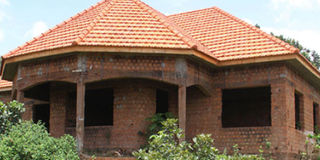What you need to know about roof pitching

While there is a standard roof pitch, different home owners now opt for different pitch degrees depending on what they want to achieve in their home. PHOTO BY ABUBAKER LUBOWA
Home owners have different options of pitching their roofs. While some opt for high ly raised roofs, others settle for low ones or flat roofs.
Engineer Bunnett Bagombeka of Franbag Bau Uganda Limited explains that the minimum roof pitch is the lowest angle at which a roof can be designed to cover the people and things underneath and that all roofs have a minimum pitch.
Bagombeka says initially, a minimum roof pitch at an angle of 20 degrees was recommended in the British sytle. With time, he says modern tiles and roofs have now been designed for usage at as low as 15 degrees to the extent that it is uncommon to find a roof below 15 degrees.
Importance of a roof pitch
The main reason for having a roof pitch is to redirect water away from the roof and avoid any percolation that might result from stagnation of water on the roof.
Other than directing away water, there are still a number of reasons as to why the pitch is such an important component.
It will, Bagombeka observes, dictate a number of other roof features such as the roofing material to be used, the architectural properties of the roof, the roof sections to be covered. The pitch also affects the economic aspects of the installation. “For instance, steep pitches lead to more roofing material being used. In turn, this will result in a higher roof installation cost,” he reasons.
Recommended roof pitch
“To get the minimum pitch for a metal roof, the vertical rise per foot is divided by the horizontal slope. Most metal roofs will have minimum pitches of three in 12 but this might sometimes go down depending on whether there are special installation procedures issued by the manufacturer regarding that particular roofing material,” he adds, advising that to be on the safe side, it is recommended that you first have a look at the manufacturer’s recommendations about the minimum pitch for metal roofs before you decide on any form of customisation.
Flat roofs
Flat roofs form the bulk of the roofs for commercial and industrial buildings in Uganda.
Though their construction appears to be simple due to technical considerations that come into play during the construction and installation phases, Joseph Oryang, an engineer at Century Investors Limited, says flat roofs are not common among people with residential houses because they cover a large area that might come at a cost.
“The lower or flatter the roof pitch, the more the chances of leaking every time it rains. This is what most people want to avoid. They don’t want to incur other costs of re-roofing,” Oryang explains.
Bagombeka adds that a well designed and constructed flat roof should facilitate the quick and effective flow of water from the roof surface to the gutters without allowing formation of ponds on the surface because formation of ponds on flat roofs is detrimental to the longevity and effectiveness of the roof.
As a result, the ponds will do nothing but lead to siltation which will create stress on the roof membrane thus causing the destruction of the roof cover.
What to consider
Due to the fact that there are many roofing styles and different kinds of roofing materials, there is no minimum roof pitch. Moses Baba an engineer with Baba, Construction Experts explains that in most cases, manufacturers will recommend the minimum roof pitch for their roofing materials but ultimately, it lies upon the installer to come up with a considerate pitch since every roof is unique and requires different considerations.




